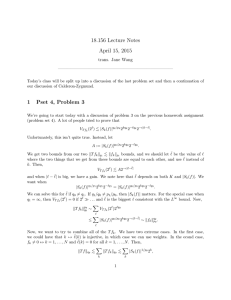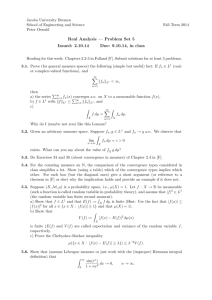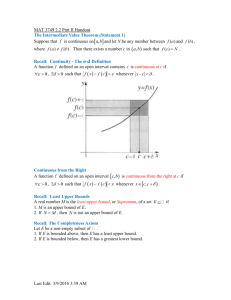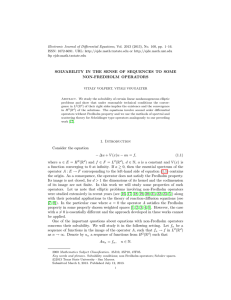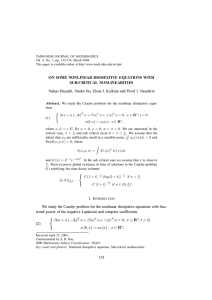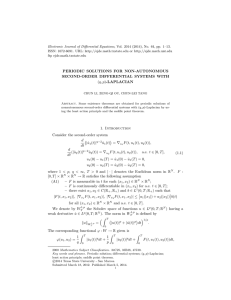18.156 Lecture Notes April 13, 2015 trans. Jane Wang ——————————————————————————
advertisement
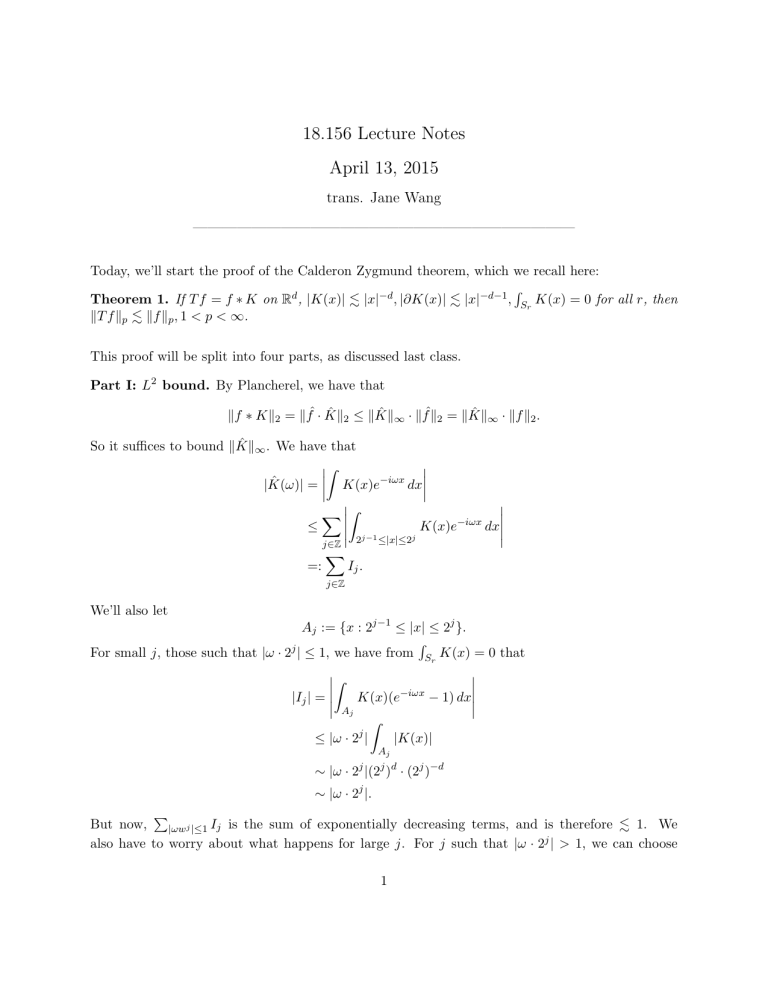
18.156 Lecture Notes
April 13, 2015
trans. Jane Wang
——————————————————————————
Today, we’ll start the proof of the Calderon Zygmund theorem, which we recall here:
´
Theorem 1. If T f = f ∗ K on Rd , |K(x)| . |x|−d , |∂K(x)| . |x|−d−1 , Sr K(x) = 0 for all r, then
kT f kp . kf kp , 1 < p < ∞.
This proof will be split into four parts, as discussed last class.
Part I: L2 bound. By Plancherel, we have that
kf ∗ Kk2 = kfˆ · K̂k2 ≤ kK̂k∞ · kfˆk2 = kK̂k∞ · kf k2 .
So it suffices to bound kK̂k∞ . We have that
ˆ
|K̂(ω)| =
K(x)e−iωx dx
≤
X ˆ
j∈Z
=:
K(x)e−iωx dx
2j−1 ≤|x|≤2j
X
Ij .
j∈Z
We’ll also let
Aj := {x : 2j−1 ≤ |x| ≤ 2j }.
´
For small j, those such that |ω · 2j | ≤ 1, we have from Sr K(x) = 0 that
ˆ
K(x)(e−iωx − 1) dx
|Ij | =
Aj
ˆ
≤ |ω · 2j |
|K(x)|
Aj
j d
∼ |ω · 2j |(2 ) · (2j )−d
∼ |ω · 2j |.
P
But now,
|ωwj |≤1 Ij is the sum of exponentially decreasing terms, and is therefore . 1. We
also have to worry about what happens for large j. For j such that |ω · 2j | > 1, we can choose
1
` ∈ {1, 2, . . . , d} such that |ω` | & |ω| and integrate by parts to get that
ˆ
|Ij | =
K(x)e−iωx dx
Aj
ˆ
ˆ
1 −iωx
1
=
∂` K ·
e
dx +
Ke−iωx ·
dx
iω`
iω`
Aj
∂Aj
ˆ
ˆ
1
1
≤
|∂K| ·
dx +
|K| ·
|ω|
|ω|
Aj
∂Aj
1
1
. |Aj |(2j )−d−1 ·
+ |∂Aj | · (2j )−d ·
|ω|
ω
1
∼ j .
|2 ω|
P
Again, |ω2j |>1 Ij is bounded by an exponentially decaying series, and so this sum and therefore
the whole sum . 1. This gives us the L2 bound that we wanted.
We note here that sometimes in the statement
of Calderon Zygmund, the L2 bound kT f k2 . kf k2
´
is taken to be a condition instead of Sr K(x) = 0.
Part II: Weak L1 bound. We want to prove the statement
VT f (λ) . kf k1 λ−1 .
(1)
We will do this by breaking up the function f into a small part and a “balanced part”. Let us first
show that a weak L1 bound holds for “small” and “balanced” functions. We’ll start with small
functions.
Lemma 2. If kf k∞ ≤ 10λ, then (1) holds.
Proof. This follows from the L2 estimate.
VT f (λ) ≤ kT f k22 · λ−2 . kf k22 · λ−2 . kf k1 · λ−1 .
For example, if we had the function f = H · χBr for λ H. Then, we would have that
|T f (x)| . f ∗ |x|−d =: g.
And λ = H · rd · R−d so Rd · λ ∼ H · rd ∼ kf kL1 , and this bound makes sense.
P
Here’s another example where we couldn’t employ this reasoning. Let f = j χBj where Bj =
B(xj , r) and xj are spaces with spacing s in a large finite grid. Then, again, we would have that
|T f | . |f ∗ |x|−d |, but it is an exercise to check that the right hand side is too big to get a bound
of the type that we want. Instead, we have to use that |T f | |f ∗ |x|−d | by cancellation.
2
Lemma 3. If b(x) is “balanced for λ”, supp b ⊂ cube Q,
λ · µ−d−1 . Here, µs is the distance from x to Q and µ ≥ 2.
´
− |b|
Q
= λ,
´
Qb
= 0, then |T b(x)| ≤
x
s
Q
Proof. Note that
µs
ˆ
ˆ
|b| ∼ λ · µ−d ,
|b| · |K(x − y| dy ∼ (µ · s)−d
|T b(x)| ≤
Q
Q
but we can do better than that. If y0 is the center of Q, then have that
ˆ
|T b(x) =
b(y)K(x − y) dy
Q
ˆ
b(y)(K(x − y) − K(x − y0 )) dy .
=
Q
Now, since K(x − y) − K(x − y0 ) . s · maxy∈Q |∂K(x − y)| . s · (µs)−d−1 , we have that
ˆ
−d−1
|b(y)| ∼ µ−d−1 · λ.
|T b(x)| . s · (µs)
P
Lemma 4. If b =
bj , bj balanced functions for λ, and each function bj is supported on Qj
disjoint sets, then VT b (λ) . kbk1 · λ−1 .
P
S
Proof. We have that kbk1 ∼ λ j |Qj |. Let U := j 2Qj . Then, |U | . kbk1 · λ−1 . So it suffices to
check that kT bkL1 (Rd \U ) . kbk1 , and for this it suffices to check that kT bj kL1 (Rd \2Qj ) . kbj k1 , since
then we would have that
X
X
X
kT bkL1 (Rd \U ) ≤
kT bj kL1 (Rd \U ) ≤
kT bj kL1 (Rd \2Qj ) .
kbj k1 = kf k1 ,
j
j
j
since the bj have disjoint supports. But that kT bj kL1 (Rd \2Qj ) . kbj k1 follows from integrating the
last lemma.
Our next step will be to decompose functions into balanced and small parts so we can use the above
results.
0
Lemma 5 (Calderon-Zygmund Decomposition Lemma).
P For all f ∈ Cc , λ > 0, we can decompose
f = b + s where kbk1 +´ksk1 . kf
´ k1 , kskL∞ ≤ λ, b = bj where bj is balanced for λ and supported
on disjoint Qj , where −Qj bj . −Qj f . λ.
3
We’ll prove this lemma next time, but we can first show that this lemma will imply part II of the
proof of CZ. Given this lemma, we would have that
VT f (2λ) ≤ VT s (λ) + VT b (λ) . ksk1 λ−1 + kbk1 λ−1 . kf k1 (2λ)−1 .
Let’s conclude today with an example of how we might split a function f into a small and a balanced
part. Let
X
f=
χBj
j
where Bj = B(xj , 1) and xj are in a grid with spacing
1, s−d ≤ λ 1. Then, we P
could choose
´
cubes Qj of width s centered at the xj such that −Qj |f | ∼ λ. Then, we could let s = j λχQj and
bj = χBj − λχQj .
4
